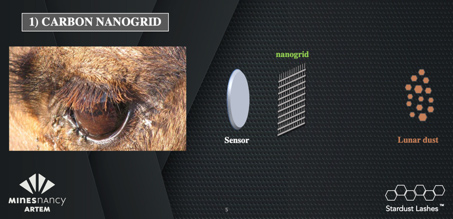«Stardust Lashes» is an innovative solution which enables the protection and self-cleaning of sensors even in a hostile environment, such as on the moon
Congratulations to Charles Chou, Clément Sagette and Rafaël Maurin, engineering students at Mines Nancy and currently enrolled in the new entrepreneurship course, who won first prize with their Stardust Lashes project at the SpaceHack Luxembourg, organised by the Technoport SA in the middle of November. This was the second year running that a team of student engineers from Mines Nancy won the competition, thereby highlighting their high level of interest in the space and aerospace sector and the pertinence of their project proposal.
Destination Moon
A total of 46 competitors from nine different countries working in 13 teams took part in the SpaceHack Luxembourg which this year focused on the colonization of the moon in 2040. Their combined expertise, capacity for hard work and technical skills were put to the test as they worked through the different stages of designing a solution which could be applied both on Earth and in space. This was a unique opportunity for the teams of aspiring entrepreneurs to develop their business skills over the 48 hours of a weekend to create a complete product from its design through to the business plan.
It was in this context that the three students from Nancy imagined the «Stardust Lashes» project under the careful guidance of coaches Laurent Ciarletta, Didier Fass, Jean-Paul Henry et Franck Gechter, which later went on to win top prize thanks to the unanimous verdict of the jury.
What are Stardust Lashes?
«Stardust Lashes» is an innovative solution which enables the protection and self-cleaning of sensors even in a hostile environment, such as on the moon. It is capable of protecting any type of sensor thanks to an ultra-light device made of carbon nanogrids; the solution is also sustainable in energy thanks to the use of micro-spines with electrostatic properties which allow it to regulate its energy consumption.
Imagine now you are mining on the moon. You have just started digging and already you are surrounded by a thick cloud of dust. You have zero visibility and it is impossible to continue working. Lunar dust is in fact a formidable enemy.
· It is abrasive and is as sharp as a razor.
· It is very fine and gets into everything.
· Its electrostatic properties will attract it to you.
A robot will not do any better. In order to dig properly a robot requires sensors which are dedicated to each specific task (lasers, radar, spectrometers). These sensors will be completely covered in lunar dust, thereby making it impossible to work.
An innovation inspired by biomimetics and AI
When starting out on their search for a solution to the lunar mining problem, the team thought about analogue conditions on Earth. Naturally, they thought of the desert and of the camel which is perfectly adapted to living in such hostile conditions. In fact, the camel has a double row of eye lashes which allow it to see even during a sand storm. The team therefore took inspiration from this natural phenomenon to design a grid of carbon nanotubes, with as a bonus, electron guns which make it possible to pulverize the dust.
Nowadays, industry is being revolutionized by the arrival of artificial intelligence. The objective of AI is of course to analyze data, but in order to carry out any analysis, the data must first be collected. This is where sensors play a crucial role in the digitalization of our industry. And to do their job properly, the sensors have to the clean. In addition to the space context, which was imposed during the hackathon, the number of applications on Earth are multiple, e.g. agriculture, construction, mineral extraction. Whether on Earth or in space, sensors are an essential component in which companies must invest on the route to their own digitalization.
What next?
The team sees the future of the project in two stages. First, they intend to discuss the project as a team and then consult a committee of experts from the space sector to obtain their feedback on the project and its feasibility. At the same time they will undergo coaching in Luxembourg, which is offered as part of the winners’ package, so that they can develop a design prototype with the help of a concurrent design facility. Once this phase is completed – and depending on its results - the aspiring entrepreneurs will then decide whether to start the R&D phase and develop the product to market. To be continued…



